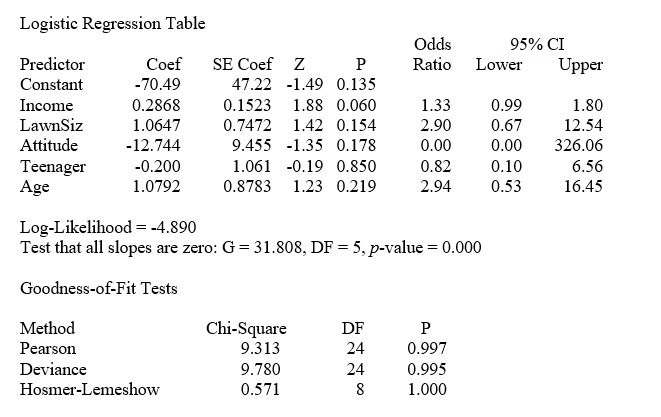TABLE 14-19
The marketing manager for a nationally franchised lawn service company would like to study the characteristics that differentiate home owners who do and do not have a lawn service. A random sample of 30 home owners located in a suburban area near a large city was selected; 15 did not have a lawn service (code 0) and 15 had a lawn service (code 1). Additional information available concerning these 30 home owners includes family income (Income, in thousands of dollars), lawn size (Lawn Size, in thousands of square feet), attitude toward outdoor recreational activities (Atitude 0 = unfavorable, 1 = favorable), number of teenagers in the household (Teenager), and age of the head of the household (Age).
The Minitab output is given below: 
-Referring to Table 14-19, what should be the decision ('reject' or 'do not reject') on the null hypothesis when testing whether Teenager makes a significant contribution to the model in the presence of the other independent variables at a 0.05 level of significance?
Definitions:
Termination Pay
Compensation given to an employee when their employment ends as per the terms of their work contract, often depending on the duration of employment.
Asset Write-downs
Reductions in the book value of assets when their fair market value falls below the carrying value on the balance sheet.
Revenues and Gains
Measures of income for a business, where revenues come from primary operations and gains from secondary activities or the sale of assets.
Peripheral Activities
Secondary or non-core operations of a company that are not essential to its primary business functions.
Q6: A first-order autoregressive model for stock sales
Q16: Referring to Table 14-15, the alternative hypothesis
Q28: Referring to Table 14-6, what are the
Q37: The purpose of a control chart is
Q55: Referring to Table 14-5, one company in
Q74: Referring to Table 16-13, what is the
Q83: Referring to Table 16-8, the forecast for
Q110: If the residuals in a regression analysis
Q160: Referring to Table 16-13, what is the
Q332: Referring to Table 14-11, in terms of